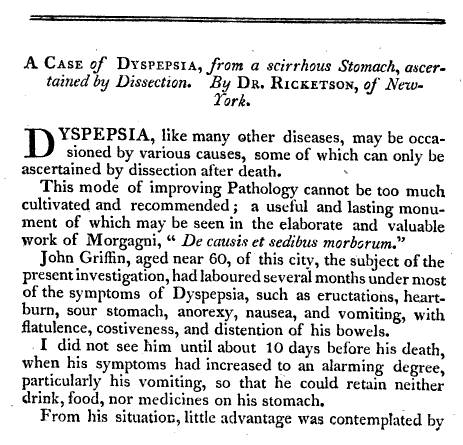At times, Shadrach Ricketson’s practices and activities as a physician were very controversial. The use of human dissection to train physicians was one of the most controversial topics he was ever engaged in. Human dissection was not new to American medicine in 1806, but is was still a fairly scarce event engaged in either privately, in an official medical school or some hospital supported surgical theater setting.
Ricketson’s first experience with a dead body was probably during his apprenticeship years. He was trained by a ship surgeon from the Revolutionary War, and so his mentor/trainer was very familiar with human anatomy and how to best demonstrate and pass this knowledge on to new physicians.
As he became more engaged in his practices and social responsibilities as a doctor, Ricketson on one occasion gave a public demonstration of a human body dissection. One of the Quaker Elders from his congregation died, leading Ricketson to do a semi-forensic review of the elder’s body, uncovering and displaying to whomever attended this event which according to the Poughkeepsie Journal was open to the public. Needless to say, even though this was a very new type of social event, making such a process open to the public, it was not as openly and publicly repeated in the City of Poughkeepsie ever again during the next several decades.
The following article details a case which Ricketson engaged in a post-mortem dissection for. The purpose of his dissection was to ascertain the possible cause for the patient’s dyspepsia. Typically this term relates to “indigestion” and the like. But during this period in medical history, there were other reasons for the discomfort the patient was felling in his stomach. The description Ricketson provides is for either of two possible medical problems:
a. it is for a tumor of sorts (benign or malignant) at the lower end of the stomach which blocked the passage of food into the duodenum.
b. it is for a peptic ulcer of long time endurance, resulting in scarification and hypertrophy of the neighboring tissues so as to [roduce the thickening of this section of the stomach.
The presence of a yellowish fluid in the abdomen suggests the development of an infected ulcer leading to ascites, although a cancerous growth may have caused the infection to develop as well.
Ricketson blames this scarring or development of a “coriaceous or callus” condition on alcohol consumption. The scirrhous (hardened) nature of the thickened stomach lining can represent cancer, but this solidness is more related to peptic ulcer development. (Solidness tends to be lacking in typical non-petic ulcers.)
.
.


Leave a comment